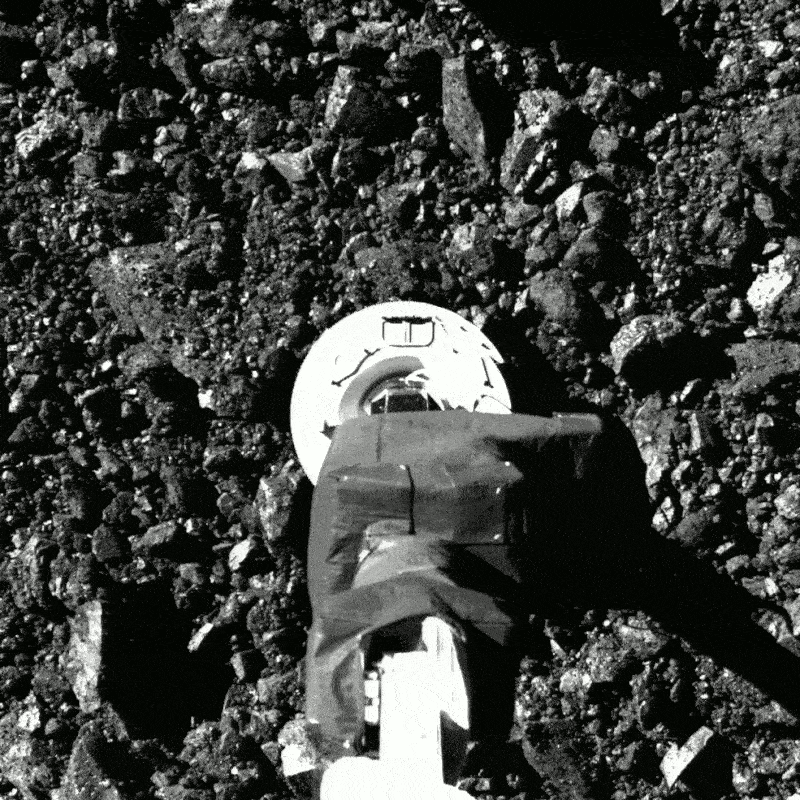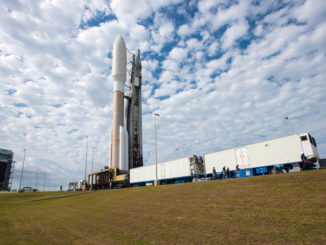
Working under close supervision from ground controllers more than 200 million miles away, the robotic arm on NASA’s OSIRIS-REx spacecraft has begun placing specimens collected from an asteroid last week into a return capsule to bring the material back to Earth in 2023, officials said Wednesday.
Images beamed back by the OSIRIS-REx spacecraft this week show the mission’s Touch And Go Sample Acquisition Mechanism, or TAGSAM, arm has placed its sample collection head inside the return capsule.
“These spectacular images taken by OSIRIS-REx show how the team has maneuvered the spacecraft arm to place the sample of asteroid Bennu into the capsule that will return to Earth,” tweeted Thomas Zurbuchen, associate administrator of NASA’s science mission directorate. “Next, the team will remove the arm from the sampler head & close the capsule.”
The sample head seen in the images is about the diameter of a dinner plate.
NASA’s OSIRIS-REx spacecraft touched down on asteroid Bennu on Oct. 20 for six seconds, long enough to fire a bottle of compressed nitrogen gas to help blow soil and rock particles into a collection chamber.
NASA’s $1 billion Origins, Spectral Interpretation, Resource Identification, Security, Regolith Explorer mission launched Sept. 8, 2016, from Cape Canaveral aboard a United Launch Alliance Atlas 5 rocket. OSIRIS-REx’s primary goal is to return asteroid samples to Earth for detailed analysis by scientists, who hope to uncover clues about the origins of the solar system.
The mission requirement was for OSIRIS-REx to gather at least 60 grams, or 2.1 ounces, of asteroid material. Scientists said before the Oct. 20 touch and go landing that the spacecraft could collect much more.
That’s what happened.
Imagery downlinked from OSIRIS-REx last week showed samples leaking out of the the TAGSAM head. At least five small rocks jammed into the opening of the sample collection chamber, preventing its mylar seal from closing.
Data from the touch and go landing indicated the spacecraft’s 11-foot-long (3.4-meter) robotic arm sunk up to 19 inches (48 centimeters) into the Bennu’s soft surface.
Diamond-shaped asteroid Bennu measures about a third of a mile wide and rotates once on its axis every 4.3 hours. Surveys of the asteroid indicate it is rich in carbon and hydrated minerals, two key building blocks of life.

“When the head is buried below the surface before the gas discharges, is the ideal circumstance to collect the maximum amount of material,” said Jason Dworkin, OSIRIS-REx’s project scientist, in a presentation Tuesday to the Maryland Space Business Roundtable. “The TAGSAM is pre-loaded with approximately a liter of regolith before the gas fires to force more in. So this was beyond our expectations.”
The images last week showed the sample head was overflowing with asteroid material, perhaps approaching the canister’s capacity of around 4.4 pounds, or 2 kilograms.
“We believe we have well above our requirement of 60 grams, probably closer to the hundreds or thousands of grams level,” Dworkin said.
Mission managers planned to extend the robotic arm and put OSIRIS-REx in a spin last weekend to measure the spacecraft’s moment of inertia, yielding an estimate of the sample mass collected from Bennu.
But movements of the robotic arm were causing more specimens to leak out of the sample collection chamber. With ample evidence that OSIRIS-REx had gathered more than the required sample mass, NASA officials directed ground teams to begin stowing the material inside the spacecraft’s return capsule sooner than planned.
“We estimate that we are losing grams to tens of grams when we maneuver the arm around,” Dworkin said Tuesday. “Interestingly, we’re losing more material than the combined total collection of all sample return missions, except for those to the moon.”
Despite the loose asteroid material leaking from the collection chamber, Dworkin said he did not expect any problems stowing the TAGSAM head inside the 2.6-foot-wide (80-centimeter) return capsule.
After the opening the sample return carrier’s lid, ground teams sent commands for the robotic arm to place the TAGSAM head onto a capture ring inside the capsule.

NASA said Wednesday that the sample head was seated into the capsule’s capture ring. Then ground controllers at a Lockheed Martin facility near Denver sent commands for the robotic arm pull on the sample head to ensure its latches were well secured.
Telemetry from the spacecraft confirmed the sample head is latched in place, according to NASA.
The next step will involve activating a “tube cutter” to cut lines leading from the sampling device’s nitrogen gas bottles, and fire a separation bolt to sever the TAGSAM head from the robotic arm. Those operations were scheduled to be commanded by ground teams as soon as Wednesday night.
Once the sample head is cut from the arm, ground teams will send commands to close the heat shield on the sample return capsule to seal it for the journey back to Earth.
Unlike OSIRIS-REx’s touch and go landing — which the spacecraft executed autonomously — the sample stow procedure involves numerous starts and stops, allowing engineers to receive imagery and assess how the operation is going at each major step.
“The reason we’re taking our time is we don’t want to lose those particles,” Dworkin said. “I like to think of every speck we see (escaping) as someone’s PhD being lost. There’s so much information that’s going away.”
OSIRIS-REx has been slowly backing away from Bennu since the touch and go landing Oct. 20.
In March, the spacecraft will fire its thrusters begin the trip back to Earth. OSIRIS-REx will release the sample return capsule for a parachute-assisted landing at the Utah Test and Training Range on Sept. 24, 2023.
Email the author.
Follow Stephen Clark on Twitter: @StephenClark1.



